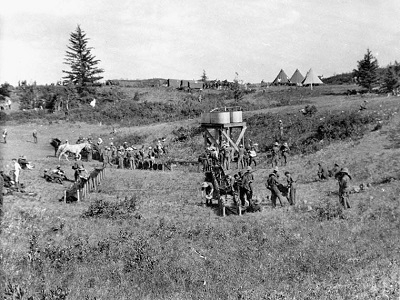Camp Hughes National Historic Site of Canada
Hughes, Manitoba

Scene taken at Camp Hughes, 1914
© Canada. Dept. of National Defence | Ministère de la Défence nationale /Library and Archives Canada | Bibliothèque et Archives Canada
Address :
Provincial Road 351, Camp Hughes, Hughes, Manitoba
Recognition Statute:
Historic Sites and Monuments Act (R.S.C., 1985, c. H-4)
Designation Date:
2011-07-19
Dates:
-
1915 to 1916
(Significant)
-
1934 to 1934
(Demolition)
-
1909 to 1909
(Established)
Event, Person, Organization:
-
Vimy Ridge National Historic Site
(Event)
-
Battle of Passchendaele National Historic Event
(Event)
-
Sir Samuel Hughes, National Historic Person
(Person)
Other Name(s):
-
Camp Hughes
(Designation Name)
-
Camp Sewell
(Other Name)
Research Report Number:
1966-007, 2009-079
Plaque(s)
Existing plaque: Provincial Road 351, Camp Hughes, Hughes, Manitoba
Named after Sir Sam Hughes, Minister of Militia and Defence (1911–1916), this site contains the most intact First World War battlefield terrain created for training purposes in Canada. One of a dwindling number worldwide, it retains many key features including trenches, a rifle range, grenade training grounds, gun positions, and observation posts. It recalls Canada’s determination to provide training specific to the tactics and conditions of the war overseas. A tangible link to Canada’s military effort, Camp Hughes still evokes the contributions and sacrifices of those who served during the Great War.
Description of Historic Place
Camp Hughes National Historic Site of Canada is located south of the Trans-Canada Highway 10 kilometres west of Carberry, Manitoba. Formerly a First World War military training camp, it is one of the most intact simulated battlefield terrains in Canada. The site consists of rolling open grassy fields, remnants of the military camp consisting of administration and training areas, a cemetery and archaeological vestiges. Official recognition refers to the 420 hectare parcel of land including training trenches, rifle range, grenade training ground, artillery observation posts and a cemetery.
Heritage Value
Camp Hughes was designated a national historic site of Canada because:
- it is the most intact First World War battlefield terrain, created for training purposes, remaining in Canada and one of a dwindling number worldwide;
- it retains in whole or in part many key features including the training trenches, rifle range, grenade training grounds, artillery observation posts, building foundations, and a camp cemetery. The trenches and rifle range, in particular, speak to Canada's efforts to provide training tailored to the specific tactics and conditions of the First World War; and, it provides a powerful and evocative illustration of Canada's participation, contribution and sacrifices during the First World War.
The heritage value of Camp Hughes lies in its physical fabric and historical associations. It was at this camp that tens of thousands of Canadian soldiers received instruction in the tactics and weaponry of war prior to being deployed to Europe during the First World War. Battlefield conditions, including a system of trenches, grenade pits, and a rifle range, were created to reflect the realities of trench warfare. Many of the soldiers who trained at Camp Hughes went on to fight at Vimy and Passchendaele, defining battles in Canada’s history. The camp served as a military training facility until 1934 when it was dismantled as part of an unemployment relief project.
Character-Defining Elements
Key elements contributing to the heritage value of this site include: - the intactness of the landscape including surface imprints and subsurface components associated with military trench warfare during the First World War; the approximately 10 kilometres of intact main battalion trench system including front- and support-line trenches, dugouts and fire bays, communication trenches, island traverses, and the Battalion Headquarters position known as Dulmage Dugouts; - the rifle range including evidence of the target house; - the grenade school training area including throwing bays and grenade pit; - the artillery range and observation post; - the camp cemetery and the entrance marked by a peaked-roof wooden gate; - the archaeological features including building foundations of the Midway, west camp training area, central camp area, and administration area; - the integrity of any surviving archaeological remains relating to the site’s use as a camp during the period from 1909 to 1934; - the viewplanes within the camp which contribute to an understanding of the site.